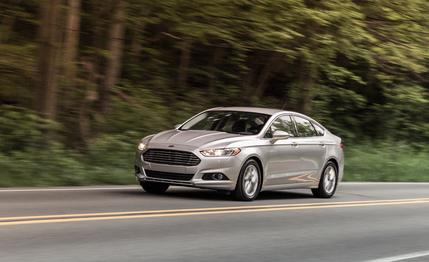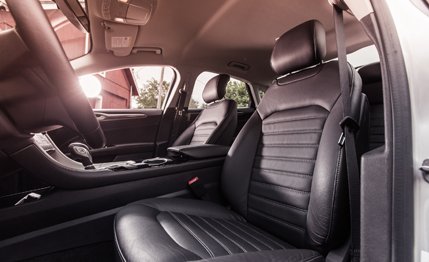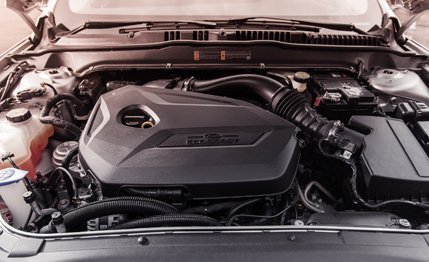 Instrumented Test
TESTED
Instrumented Test
TESTED
It’s no secret that the latest Fusion is the most competitive mid-size sedan from Ford in a long time, and of the many variants on offer, the combination of the 1.6-liter EcoBoost (that’s “turbocharged and direct injected” in blue-oval-ese) four-cylinder with the six-speed automatic transmission has played a key role in the achievement.
That’s not surprising. This particular Fusion has a number of virtues. It’s quiet even by the standards of a generally quiet class, particularly at freeway speeds. It’s a smooth operator on most surfaces and, given its pleasant road manners, surprisingly agile. It offers stop-start technology, shutting down the engine at stoplights, which is a feature unique to the 1.6 automatic among the various Fusion choices. This contributes to respectable EPA fuel-economy ratings of 25 mpg city and 37 highway. But for all its positives, this engine-and-transmission pairing isn’t much fun. So what’s the problem?

The Automatic Factor
Consistent with Ford’s transition to smaller engines (there is no longer a V-6 in the Fusion powertrain inventory), the 1.6 employs turbocharging to extract more power from less displacement while shooting for high marks on the government’s efficiency tests. Although this is to some extent a fool’s errand—the EPA dyno rollers bear little relationship to the operating realities of America’s streets and interstates—it’s the common response across the industry to the lofty efficiency requirements mandated by various global entities.
Teetering on the tightrope between acceptable performance and high mpg, the 1.6 turbo delivers 178 horsepower at 5700 rpm and 184 lb-ft of torque at a reasonably low 2500 rpm. Assigned to towing a substantial mid-size sedan, these aren’t prepossessing output numbers, but if the driver keeps the turbo spooled up—the antithesis of driving for high mpg (we averaged 22 mpg)—there’s enough snort to make the Fusion a reasonably effective ally for dissecting day-to-day traffic.
Effective, however, only applies once the car is moving. Getting the 1.6 Fusion automatic swiftly out of the starting blocks requires some skilled brake-torquing to get a chirp of wheelspin—the better to minimize engine bog—but even then the driver’s danger of acceleration blackout is nil: In this case, 0 to 60 mph in 8.2 seconds and through the quarter-mile in 16.2 seconds at 86 mph. In a recent comparison test versus the Honda Accord, Nissan Altima, and Volkswagen Passat, a Fusion 1.6 automatic was slowest of the group.

A 1.5-liter EcoBoost four that will come online later this year is likely to deliver similar performance as recorded here, as it offers the same horsepower and only slightly less torque than the 1.6, which will remain in the fold as a manual-only proposition. The 1.5 will be mated solely to the automatic transmission. (If you’re wondering why Ford will offer 1.5 and 1.6 EcoBoost fours, it’s odd but easily understood—blame China and the Ford Escape.)
Beyond the lack of haste, and a bit more frustrating, the automatic’s upshifts are deliberate, and throttle-induced downshifts—when you want to get up and go in a hurry—are more so. In Sport mode, the driver controls gearchanges with a thumb switch on the upper left side of the shift lever. Even though the transmission will hold a particular gear at the rev limiter (6500 rpm), up- and downshifts are still too relaxed, and the thumb-switch control is simply not satisfying. Nor is it as effective as paddle shifters. The function of the engine stop-start feature is less intrusive than most others, although it can become a little tedious in stop-and-go traffic. In any case, what we have with the 1.6 automatic is a chassis that’s faster than its powertrain.